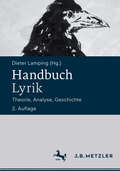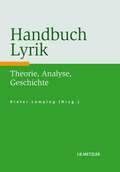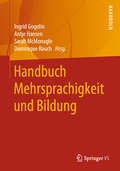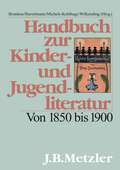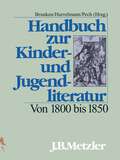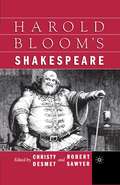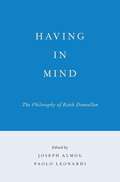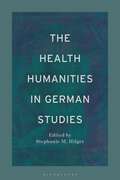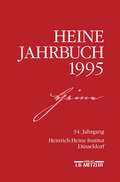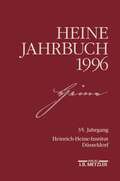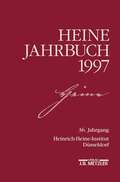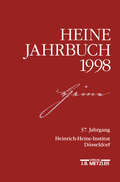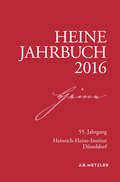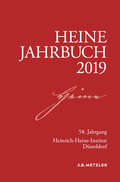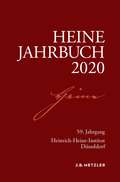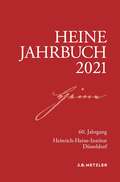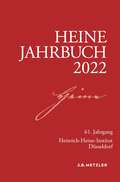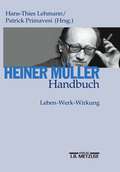- Table View
- List View
Handbuch Lyrik: Theorie, Analyse, Geschichte
Die Neuauflage des Standardwerks bringt neue Kapitel zu den Themen Lyrik und Komik, Lyrik und Bibel, Lyrik und Emotion, zum Verlegen und zum Unterrichten von Lyrik sowie zur aktuellen Gegenwartslyrik. Das komparatistisch ausgerichtete Handbuch stellt die Poetiken der Lyrik seit der Antike und die wissenschaftlichen Gattungstheorien vor. Es umreißt Tendenzen der neueren Lyrikforschung und macht mit Grundbegriffen der Interpretation vertraut. Die Themen und Verfahren der Lyrik werden ebenso behandelt wie das Verhältnis zu anderen Genres, inklusive Film und Pop. Auch Aspekte der Lyrikvermittlung kommen zur Sprache. Am Schluss steht ein Epochenüberblick von der Antike bis in die Gegenwart.
Handbuch Lyrik: Theorie, Analyse, Geschichte
Gesamtüberblick über die Gattung der Lyrik. Das komparatistisch ausgerichtete Handbuch stellt die Poetiken der Lyrik seit der Antike und die wissenschaftlichen Gattungstheorien vor. Es umreißt Tendenzen der neueren Lyrikforschung und macht mit Grundbegriffen der Interpretation vertraut, wie z. B. Form, Sprache und Medialität. Die Themen und Verfahren der Lyrik werden ebenso behandelt wie das Verhältnis zu anderen Genres, inklusive Film und Pop. Auch Aspekte der Lyrikvermittlung kommen zur Sprache - darunter: Übersetzung, Edition, Lesung und Lyrik in der Schule.
Handbuch Mehrsprachigkeit und Bildung
Das Handbuch fungiert als Nachschlagewerk, das Theorie, empirische Forschung und praxisrelevante Erkenntnisse aus den dynamischen Forschungsfeldern Mehrsprachigkeit und Bildung in ihrer Verschränkung präsentiert. Die behandelten Themen schließen den internationalen Stand der Forschung und Entwicklung ein. Beiträge über Traditionen der Konzeptualisierung von Sprache und Bildung ermöglichen ein besseres Verstehen heutiger ‚Normalvorstellungen‘ und repräsentieren multidisziplinäre Perspektiven. In Zeiten der Globalisierung und großräumiger individueller Mobilität ist dieses Werk nicht nur von aktueller Bedeutung, sondern auch zukunftsrelevant.
Handbuch Sprachkritik
Sprachkritik ist – in einem ganz allgemeinen Verständnis – die positive wie negative Würdigung der menschlichen Sprache und ihrer Leistungen sowie des Gebrauchs, der von ihr gemacht wird. Diese Würdigung kann sich auf verschiedene Sprachbeschreibungsebenen beziehen: etwa auf das Wort und auf den Satz, auf den Text und auf den Diskurs, auf die Rechtschreibung und auf den Stil. Als wissenschaftliche Handlung setzt Sprachkritik theoretische Grundlagen, systematische Ansätze und Methoden der Beschreibung und Bewertung von Sprache und Sprachgebrauch voraus. Ausgehend von dem Konzept der funktionalen Angemessenheit präsentiert das Handbuch den aktuellen Forschungsstand der linguistisch begründeten Sprachkritik.
Handbuch Sprachkritik
Sprachkritik ist – in einem ganz allgemeinen Verständnis – die positive wie negative Würdigung der menschlichen Sprache und ihrer Leistungen sowie des Gebrauchs, der von ihr gemacht wird. Diese Würdigung kann sich auf verschiedene Sprachbeschreibungsebenen beziehen: etwa auf das Wort und auf den Satz, auf den Text und auf den Diskurs, auf die Rechtschreibung und auf den Stil. Als wissenschaftliche Handlung setzt Sprachkritik theoretische Grundlagen, systematische Ansätze und Methoden der Beschreibung und Bewertung von Sprache und Sprachgebrauch voraus. Ausgehend von dem Konzept der funktionalen Angemessenheit präsentiert das Handbuch den aktuellen Forschungsstand der linguistisch begründeten Sprachkritik.
Handbuch zur Kinder- und Jugendliteratur: Von 1850 bis 1900
Wichtiger Baustein zur Erforschung der deutschsprachigen Kinder- und Jugendliteratur. In repräsentativer Auswahl werden die zentralen Werke aller Gattungen der Kinder- und Jugendliteratur von 1850 bis 1900 vorgestellt. Mit der ausführlichen Bibliografie erschließt der Band 1000 Werke der aktuellen Forschung. Inklusive CD-ROM mit 780 Illustrationen aus Kinder- und Jugendbüchern.
Handbuch zur Kinder- und Jugendliteratur. Von 1800 bis 1850
Dieser reich illustrierte Handbuchband erschließt erstmals die Kinder- und Jugendliteratur der ersten Hälfte des 19. Jahrhunderts in Überblicksartikeln, Einzeldarstellungen und kommentierter Bibliographie.
Harmful Interaction between the Living and the Dead in Greek Tragedy
Fifth-century Greek tragedy contains some of the most fascinating and important stage-ghosts in Western literature, whether the talkative Persian king Darius, who is evoked from the Underworld in Aeschylus’ Persians, or the murdered Trojan prince Polydorus, who seeks burial for his exposed corpse in Euripides’ Hecuba. These manifest figures can tell us a vast amount about the abilities of the tragic dead, particularly in relation to the nature, extent and limitations of their interaction with the living through, for example, ghost-raising ceremonies and dreams. Beyond these manifest dead, tragedy presents a wealth of invisible dead whose anger and desire for revenge bubble up from the Underworld, and whose honour and dishonour occupy the minds and influence the actions of the living. Combining both these manifest and invisible dead, this book examines harmful interaction between the living and the dead, i.e. how the living can harm the dead, and how the dead can harm the living. This includes discussions on the extent to which the dead are aware of and can react to honourable or dishonourable treatment by the living, the social stratification of the Underworld, the consequences of corpse exposure and mutilation for both the living and the dead, and how the dead can use and collaborate with avenging agents, such as the gods, the living and the Erinyes.
Harold Bloom's Shakespeare
Harold Bloom's Shakespeare examines the sources and impact of Bloom's Shakespearean criticism. Through focused and sustained study of this writer and his best-selling book, this collection of essays addresses a wide range of issues pertinent to both general readers and university classes: the cultural role of Shakespeare and of a new secular humanism addressed to general readers and audiences; the author as literary origin; the persistence of character as a category of literary appreciation; and the influence of Shakespeare within the Anglo-American educational system. Together, the essays reflect on the ethics of literary theory and criticism.
Harold Norse: Poet Maverick, Gay Laureate (Clemson University Press: Beat Studies)
Who was Harold Norse? Despite publishing over a dozen volumes of poetry between the early 1950s and the new millennium, until now, the Brooklyn-born Norse has been relegated to a footnote in accounts of twentieth century literary history. Harold Norse: Poet Maverick, Gay Laureate is the first collection of essays devoted to this enigmatic poet and visual artist. As this volume explores, Norse, who developed his craft while living in Europe during the 1950s and 1960s, is an important figure in the development of mid-twentieth century poetics. During the 1950s and 1960s, Norse was a notable figure in the plethora of little poetry magazines published in the USA and Europe through to skirmishes with respectability and acceptance (Penguin and City Lights). Norse is a key figure in the development of the cut-up process made famous by his friend, William S. Burroughs. His correspondence with his mentor, the poet William Carlos Williams, captures his poetic shifts from formalism to the development of his Brooklyn idiom, while his gripping autobiography, Memoirs of a Bastard Angel, documents his transatlantic networks of writers and artists, among them James Baldwin, Allen Ginsberg, and Charles Bukowski. And after returning to the US in the late 1960s, Norse emerged as leading figure in Gay Liberation poetry.List of contributors: Jan Herman, Erik Mortenson, A. Robert Lee, Fiona Paton, Daniel Kane, Steven Belletto, Estíbaliz Encarnación-Pinedo, Ronna C. Johnson, Kurt Hemmer, Chad Weidner, Benjamin J. Heal, Tate Swindell, Andrew McMillan, Douglas Field, Jay Jeff Jones, Todd Swindell, andJames Grauerholz.
Hashtag Activism Interrogated and Embodied: Case Studies on Social Justice Movements
Hashtag Activism Interrogated and Embodied analyzes the ways that hashtags repurpose and reclaim societal narratives, considering how these digital interactions carry over into external spaces and are embodied by both participants and spectators alike. A diverse set of contributors from a range of disciplines utilize a variety of methodologies to interrogate the lifespan and trajectories of specific hashtag campaigns, study rhetorical strategies engaged by online communities, and analyze how hashtags are employed for particular purposes. The chapters capture twenty-first-century digital activism unfolding in different social and geopolitical climates. Delving into hashtag activism in various forms (tweets, memes, and personal narratives) and spaces (Twitter, Facebook, and in-person protests), these chapters reveal how participants question and construct online and offline identities and imagined and actualized communities. They also showcase the complicated ways hashtag activism intersects with consumer, popular, and celebrity cultures. Hashtag Activism Interrogated and Embodied calls for broader inclusion in what is considered hashtag activism, such as digital fandom, how hashtags are co-opted for nefarious purposes, the effects of anti-activism, and the role of journalism and the media. It will appeal to a range of disciplines including rhetoric and composition, internet studies, communication studies, media studies, feminist studies, affect studies, cultural studies, technical communication, and sociology. Contributors: Robert Barry, André Brock, Elizabeth Buchanan, Rosemary Clark-Parsons, Gabriel I. Green, Neha Gupta, Jeffrey J. Hall, Kyesha Jennings, Morgan K. Johnson, Salma Kalim, Megan McIntyre, Sean Milligan, Avishek Ray, Sarah Riddick, Stephanie Vie, Erin B. Waggoner, Holly M. Wells, William I. Wolff You can use only one pair of em dashes in a sentence. :(
Having in Mind: The Philosophy of Keith Donnellan
Keith Donnellan of UCLA is one of the founding fathers of contemporary philosophy of language, along with David Kaplan and Saul Kripke. Donnellan was and is an extremely creative thinker whose insights reached into metaphysics, action theory, the history of philosophy, and of course the philosophy of mind and language. This volume collects the best critical essays on Donnellan's forty-year body of work. The pieces by such noted philosophers as Tyler Burge, David Kaplan, and John Perry, discuss Donnellan's various insights particularly offering new readings of his views on language and mind.
Headless Relative Clauses in Mesoamerican Languages
Headless relative clauses have received little attention in the linguistic literature, despite the many morpho-syntactic and semantic puzzles they raise. These clauses have been even more neglected in the study of Mesoamerican languages. Headless Relative Clauses in Mesoamerican Languages constitutes the first in-depth, systematic study of the topic. Spanning fifteen languages from five language families, it is the broadest crosslinguistic study of headless relative clauses yet conducted. For most of these languages there is no previous descriptive or documentary material on wh-constructions in general, let alone headless relative clauses. Many of the languages are threatened or endangered; all are understudied. Each chapter in this volume constitutes an original contribution to typological and theoretical linguistics. The first chapter provides a comprehensive introduction to the varieties of headless relative clauses and their importance to the study of human language, while the other chapters are language-specific and follow a uniform format to facilitate comparisons and generalizations across languages. Through the collective work of a team of twenty-one scholars, Headless Relative Clauses in Mesoamerican Languages presents a clear and systematic introduction to relative and interrogative clauses in Mesoamerican languages.
The Health Humanities in German Studies
The first full-length study to bring together the fields of Health Humanities and German studies, this book features contributions from a range of key scholars and provides an overview of the latest work being done at the intersection of these two disciplines. In addition to surveying the current critical terrain in unparalleled depth, it also explores future directions that these fields may take. Organized around seven sections representing key areas of focus for both disciplines, this book provides important new insights into the intersections between Health Humanities, German Studies, and other fields of inquiry that have been gaining prominence over the past decade in academic and public discourse. In their contributions, the authors engage with disability studies, critical race studies, gender/embodiment studies, trauma studies, as well as animal/environmental studies.
Heart of Darkness (Case Studies in Contemporary Criticism)
Now in its second edition, this popular case-study of Conrad's classic short novel reprints an authoritative text together with five essays (four of which are newly-commissioned or revised) written from a range of contemporary critical perspectives.
Heine-Jahrbuch 1996: 35. Jahrgang (Heine-Jahrbuch)
Das Heine-Jahrbuch ist das internationale Forum der Forschung über den Dichter und seine Zeit: Aufsätze, Essays, Berichte, Buchbesprechungen, Bibliographie. Das Jahrbuch erscheint seit 1995 bei J.B. Metzler in jährlicher Folge; es kann zur Fortsetzung bezogen werden.
Heine-Jahrbuch 2016
2016 erscheint der 55. Jahrgang des Heine-Jahrbuchs. Mit Analysen mehrerer Heine-Vertonungen aus dem 19. und 20. Jahrhundert liegt einer seiner Themenschwerpunkte auf der musikalischen Wirkungsgeschichte des Dichters. Daneben enthält es weitere Forschungsbeiträge zu Heines Leben, Werk und Rezeption; zudem präsentiert es bisher unbekannte Briefe Heines aus dem Archiv des Heinrich-Heine-Instituts.
Heine-Jahrbuch 2019 (Heine-Jahrbuch)
Der 58. Jahrgang des Heine-Jahrbuchs enthält aktuelle Forschungsbeiträge zu Leben, Werk und Wirkungsgeschichte Heinrich Heines, Rezensionen und die neueste Bibliographie der Heine-Literatur. Außerdem dokumentiert er die Verleihung des Heine-Preises der Landeshauptstadt Düsseldorf von 2018: die Dankesrede des Preisträgers Leoluca Orlando und die Laudatio von Wim Wenders.
Heine-Jahrbuch 2020 (Heine-Jahrbuch)
2020 erscheint der 59. Jahrgang des Heine-Jahrbuchs. Er enthält aktuelle wissenschaftliche Beiträge zu Leben, Werk und Wirkung Heinrich Heines sowie zur Literatur des Vormärz, unter anderem eine Studie von Joseph A. Kruse über Heine und Fontane sowie Darstellungen über die Journalisten Saul Ascher, Ludwig Börne und Georg Bernhard Depping. Zudem präsentiert der Band neu erworbene Heine-Briefe aus dem Archiv des Heinrich-Heine-Instituts.
Heine-Jahrbuch 2021 (Heine-Jahrbuch)
2021 erscheint der 60. Jahrgang des Heine-Jahrbuchs mit wissenschaftlichen Beiträgen zu Leben, Werk und Wirkung Heinrich Heines. Unter anderem enthält er Studien von Gerhard Höhn über ästhetische Korrespondenzen zwischen Heine und Baudelaire und von Manfred Windfuhr über Heines Schriftsellerbegriff. Neben Untersuchungen zur Vorgeschichte der Heine-Säkularausgabe oder zu Heine und Delacroix präsentiert er zudem unbekannte Briefe von Fanny Lewald, Karl Hillebrand und Robert Wesselhöft, die alle mit Heine verbunden waren.
Heine-Jahrbuch 2022 (Heine-Jahrbuch)
2022 erscheint der 61. Jahrgang des Heine-Jahrbuchs. Er enthält u. a. Untersuchungen zu zwei der berühmtesten lyrischen Werke Heines: eine narratologische Analyse der „Heimkehr“ und eine Quellenstudie zum „Sklavenschiff“. Neben Artikeln von Norbert Waszek über Heines Verhältnis zu dem französischen Philosophen Victor Cousin, Ernst-Ulrich Pinkert über Heine-Rezeption in Dänemark und von Inge Rippmann und Joseph A. Kruse über Literatur und Judenemanzipation im 19. Jahrhundert präsentiert er bisher unbekannte Briefe Heinrich Heines.
Heiner Müller-Handbuch: Leben – Werk – Wirkung
Heiner Müller (1929-1995) gilt als der wichtigste deutsche Theaterautor seit Brecht. Der vorliegende Band gibt einen umfassenden Überblick über das Gesamtwerk. Über die Werkanalysen hinaus lassen die Autoren auch grundlegenden Aspekten, dem Verhältnis zur Tradition und den Stellungnahmen Müllers zum Zeitgeschehen, genügend Raum. Auf diese Weise kommt die Vielfalt von Müllers eigener Produktion ebenso zum Tragen wie die thematisch und motivisch übergreifenden Momente. Der Leser bekommt eine Vorstellung von Voraussetzungen und Wirkungen seines Schaffens und der Bedeutung von Müllers Positionen und Reflexionen zu politischen und ästhetischen Problemen. Eine detaillierte Bibliografie rundet den Band ab.
